How has COVID-19 affected the women of India?
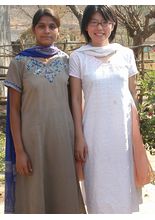
COVID-19 raged around the world in 2020, forcing people to minimize contact with others by working at home and arranging virtual—instead of in-person—family gatherings over holidays. Lifestyles have drastically changed. What are the repercussions of the increased time spent at home? According to UN Women, women’s household responsibilities are increasing more than those of men worldwide. And reports from the National Police Agency in Japan show that while the suicide rate among men remained unchanged in 2020, for women it rose by some 16 percent from the previous year. More women than men have taken leaves of absence from their jobs during the state of emergency declared by the Japanese government in the spring of 2020, according to the Japan Institute of Labour Policy and Training.
How has the spread of COVID-19 affected women in countries and regions outside Japan? We spoke with Mizuho Matsuo, Associate Professor of the National Museum of Ethnology, who has for years been studying gender in Indian society, about the state of coronavirus infections in India and the impact on women there.
What is the situation of COVID-19 infections in India (as of late January 2021, when the interview took place)?
The rate of new infections is slowing in India. In Japan there was a spike in cases from late 2020 to early 2021, calling for a state of emergency for 11 prefectures. In contrast, in India, the patient count has been dropping significantly after hitting a peak in September (Note; it has been rising again since mid-March). But more than 10 million people have tested positive in total, which is the world’s second-highest after the United States. And India has the third-worst death count in the world too, topping 150 thousand. The country has a massive 1.4 billion population, so comparing the number of cases per million people might offer a better picture: Between December 2020 and January 2021, COVID-19 cases in India hovered around 6,000–7,000 per million, whereas the figure in Japan was a little less than 4,000 as of late January.
I talked to acquaintances in Maharashtra state, west India, where Mumbai is located, and they say life is more or less back to normal now, with people traveling and attending wedding ceremonies. Wearing a mask is a new practice in India, so the number of people using face masks went down as the infection cases dropped. Things are quite different between Japan and India.
How is the COVID-19 pandemic affecting women in India?
That depends where they are in the social hierarchy. In addition to the caste system, there are major class disparities in Indian society. Consequently, poor households in the urban slums have been hard-hit by the pandemic.
Many women from the slums work in middle-class homes as domestic helpers. One characteristic of Indian society is the way many middle-class households outsource their domestic chores: Two to three people are hired to work in shifts to cook, clean, wash dishes, and handle other tasks. Compared with Japan, in India it is much more common for non-family members to come into private, family spaces. But when the spread of COVID-19 forced Indians to limit social contact, these helpers lost both their jobs and their income.
High-rise residential buildings occupied by members of the same social stratum—mainly the middle class—are a feature of Indian mega cities. They are somewhat like gated communities. But the lives of the middle-class residents had come to depend on residents of neighboring slums for their day-to-day functioning, and the high-rise lifestyle and slum communities became closely interdependent. With the raging of the coronavirus, however, the domestic helpers were laid off and prohibited from entering the buildings. The middle-class residents for the most part escaped the repercussions of the country’s lockdown, as they were able to work or shop online and support their children in attending online classes. The slum-dwellers, by contrast, having lost their jobs and incomes, some returned to home villages in the countryside and their children have less access to education. The pandemic has exposed and exacerbated India’s intrinsic inequalities.
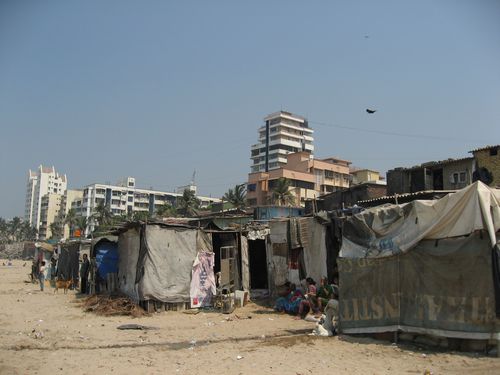
Upscale residence buildings and adjacent slum in Mumbai. The high-rise and makeshift settlement stand in close proximity. The lives of people living in the high-rises had grown dependent on neighboring slum dwellers.
Has the impact of the pandemic on middle-class women been limited?
Yes, that is my overall impression. According to some interviews with middle-class women, their biggest difficulty was having their children at home all day after schools closed due to the lockdown in March 2020. Whether you live in Japan or India, juggling childcare and telecommuting is a tough task. Because these families are hiring fewer or no helpers, more household chores need to be done. Some middle-class women are coping with the change by purchasing washer-dryers, for instance. Others have likely managed this new problem by asking help from their retired grandparents, as many Indians live in multigenerational households. Unlike women of poor households, middle-class women can still make ends meet and provide education for their children despite the effects of the pandemic.
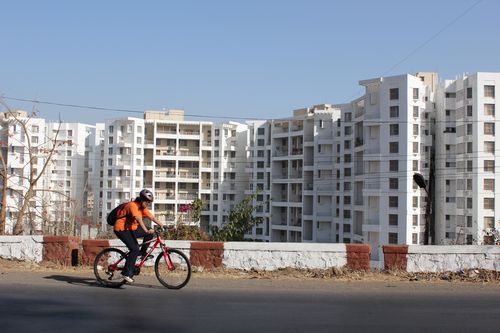
Typical apartment buildings of middle-class Indians. Pictured here is a complex under construction outside Pune.
Did any of India’s counter-COVID-19 measures stand out to you?
I see both mandatory and flexible aspects in the measures that have been taken to restrict people’s activities. Each area in Maharashtra state is divided into three zones (i.e., green, orange, and red) by the level of infection risks, allowing different types of activities to be undertaken depending on the zone. For example, if a suburban neighborhood with many detached houses is designated a green zone, then people can move about without any restriction within that area.
In Japan, state of emergency declarations to restrict the movement of people are issued on a prefecture-by-prefecture basis. To put India’s approach into the context of Japan, India is categorizing the per-region infection risks in each prefecture, and, accordingly, enforcing different rules in those regions.
What brought you your connection with India?
It goes back to when I went to Savitribai Phule Pune University in Maharashtra state as a one-year exchange student, while I enrolled in a master’s degree course in the Graduate School at Nagoya University. Back then I was majoring in development studies. As the destination for my studies abroad, I picked India, from among African and Asian countries, because it is geographically closer to Japan and I had traveled there before. I have stayed connected with Maharashtra ever since, and my current field site is there.
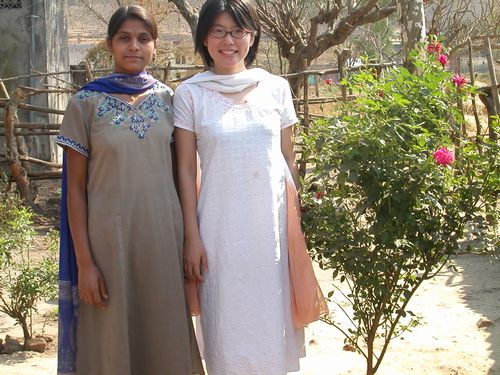
While studying at the Graduate School of Nagoya University and Sokendai University, Matsuo went to Savitribai Phule Pune University for study. Pictured here is a scene from fieldwork in a rural community, in which she conducted while studying in India.
Despite majoring in development studies in graduate school, you are now an anthropologist focusing on the society and women of India. Why did you make that change?
I majored in anthropology as an undergraduate, so I actually came back to the field after studying development. As a university student anthropology seemed at first too distant from the real world; I changed my major because I thought development studies would be more practical.
As my studies deepened, I realized that development studies is a practical discipline aimed at development of the society. In anthropology I had been trained to remove preconceptions by comparing the society to which I belong to with other societies and, so I found the basic principles of development studies did not sit well with me. For instance, to solve problems in emerging nations, specialists of development studies first list up the issues, such as the lack of clean water, schools, or hospitals. They then consider how to solve these problems. In anthropology, by contrast, we put ourselves into local peoples’ shoes and try to understand the knowledge they have; for example, nomads have knowledge about cattle-raising that has been passed down over generations and it doesn’t take a school for this knowledge to be acquired. Through my experience with developmental studies, I learned that academic fields have different foundational principles, and the one that resonated with me was that of anthropology. With this realization, I went back to anthropology for my Ph.D. Having always been interested in minorities, I felt that among the 7 billion people in the world, the world’s biggest minority is women. That’s how I started my journey to research on women.
(Interview: Ayumi Koso)
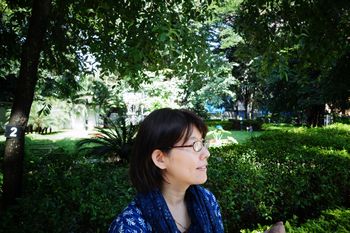
Mizuho Matsuo, Associate Professor, National Museum of Ethnology
Matsuo specializes in medical anthropology and gender studies, as well as South Asian studies. After graduating from Nanzan University, Faculty of Humanities, Department of Anthropology in 1999, she completed a master’s degree in 2002 in the Department of International Cooperation Studies, Graduate School of International Development, Nagoya University. After completing coursework at the Graduate University for Advanced Studies, School of Cultural and Social Studies, Department of Comparative Studies, she received her Ph.D. in 2008. After serving for four years as lecturer and associate professor at Niigata University of International and Information Studies, Faculty of Information Culture, she assumed her current post in 2014.
